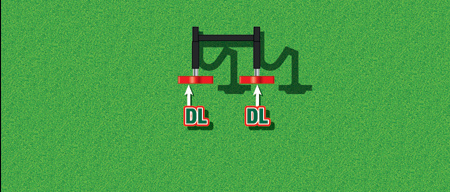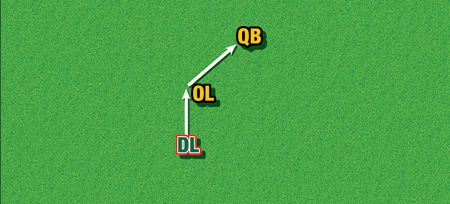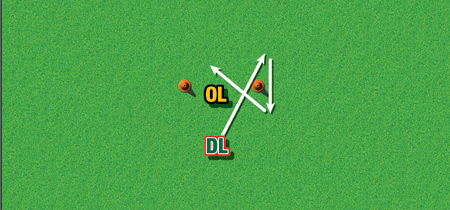Drills Report: Making Improvements In Your D-Line Pass Rush
by: Jeff EngelDefensive Line Coach, Minot State University ©
More from this issue
With the current trend of offensive football becoming more and more spread out, defensive line coaches are seeing less and less of the traditional 5-and 7-step passing game. The traditional pass rush angles and teaching progressions don’t necessarily fit in defending the “spread” offense. Pressuring the QB in the shotgun and 3-step passing game has definitely become harder and forced D-linemen to adapt as pass rushers. We have developed seven “points of emphasis” in the pass rush that serve as our teaching cues in pass rush.
• ATTACK PROTECTIONS
- BE SMART
- FIND THE WEAKEST LINK
- LINE STUNTS AND GAMES
• GREAT STARTS TO AIMING POINT
• PHYSICAL AND AGGRESSIVE
• FAST HANDS AND FAST FEET
• WIN 1 ON 1
• HIT THE QB (HURRY, SACK)
• BE RELENTLESS
Attacking Protection Schemes
We’ve tried to impress upon our defensive linemen that “Being Smart” definitely gives you an advantage in your pass rush. At Minot State, we begin our weekly game planning by trying to figure out our opponent’s pass protection schemes. Do they slide, hinge, man, or zone protect? Where do the running backs fit in the protection schemes? How often do they max protect? We try to communicate this information to our defensive players on film so they can get a better understanding of where and why we send pressures. We then look to evaluate each OL in the pass protection scheme. Who is the weakest link athletically? Who doesn’t defend power pass rush moves very well? Who doesn’t defend speed rush moves very well? Who is light, or plays with poor pad level?
Through film study, we believe our DL is well prepared in pass rush situations. We believe a smart player knows when to gamble on his rushes. We give our DL some freedom to lose contain, or change gaps, or even call their own line stunts if they believe they can beat the protection. Hopefully, we’ve taught them the difference between a good bet and a bad bet. Lastly, we look to see which line stunts and games give us an opportunity for a hurry or pressure.
Great Starts
Our philosophy on pass rush ties directly to our fundamentals for playing the run. We need to have a great get-off to an aiming point. We play ½ man technique with our helmet and hands vs. the run or the pass so the transition is fairly smooth. We’ve gone with the philosophy you can still be aggressive and physical vs. the 3-step passing game if you’re not involved in a stunt or line game. We understand the thinking of getting our hands up and trying to knock balls down, but we have the belief we can get to a QB in the 3-step game if we continue to physically attack the OL and wear them down. I’ve found if we start the teaching progression with jumping to tip thrown balls, our rushes become ineffective.
Fast Hands/Fast Feet
We talk about having fast hands and fast feet once you determine the play is a pass. We are not going to have time to distinguish between 3-step and 5-step. We don’t have time to get into a shoving match with an OL. Our feet and hands must clear the OL as quickly as possible. We treat all drop backs as a 3-step from an angle and timing standpoint. All of our pass rush drills are done to simulate 3-step quarterback drops.
Winning 1-on-1
and Pressuring the QB
We emphasize winning 1-on-1 battles vs. the OL. Essentially, each different protection scheme allows for somebody in the defensive front to be given a 1-on-1 rush vs. an OL. While three people may see a potential double team, SOMEONE is 1-on-1. When that opportunity comes, you must win! We talk daily about the 1-on-1 opportunities and try to create a sense of pride in whether we won or lost our 1-on-1 battle. We also keep a close record of “QB pressures.” Could we have hit the QB if our effort was better? Did we work into the throwing lane? Did we get our hands up when the QB sets to throw? Did the QB feel us on his backside? We want to impact every throw whether we actually sack the QB or not. In our book, hurries are just as important as sacks vs. the spread offense.
Lastly, when we play a true spread team, we will play as many DL as possible so the pass rush effort can be relentless. In our 3-4 defense we will play as many as seven DL in a given game and we also will substitute LBs into the defense to get more speed on the field.
DRILLS
We utilize five main drills to teach and improve our pass rush. Obviously there are many more drills out there, but we’ve found these five to be the most effective.
1. Lev Sled (2 Man)
We use the Rogers 2-man Lev Sled to teach great starts and attacking with the hands to an edge. We will teach a specific power pass rush move and use the sled to refine the move. We can get a high number of reps in a short amount of time and also get immediate feedback about our starts if the sled doesn’t unlock. As a conditioning tool, we will have the first guy in each line choose a pass rush move and the rest of the line then must perform that move when it’s their turn.
Purpose: To teach proper attack and escapes (See Diagram 1).

Procedure:
1. Align two single file lines facing sled.
2. On visual key, DL (from 3 pt. stance)
attacks and punches sled.
3. DL makes contact below numbers and
works up through sled.
4. Escape to edge of sled.
Coaching Points
1. Aggressive attack and punch, eyes on
numbers.
2. Quick lock-out.
3. Escape quickly.
2. Tip Pass Drill
To quickly teach having separation from an OL and working into a passing lane, we will use our tip pass drill. We will align two or three groups of OL vs. DL and put a QB at different depths. This drill works well to teach rush lanes and responsibilities, finding an open rush lane, working the timing of our rushes, and gives us the opportunity to work specific moves.
Purpose:
To teach DL
to work into
passing lanes
and tip passes (See Diagram 2).

Procedure:
1. Align OL vs. DL. At snap, QB drops to
simulate pass.
2. DL works pass rush moves.
QB pulls guide hand as if to throw.
3. DL disengages and works to passing
window to tip ball as QB throws.
Coaching Points
1. Get off the ball.
2. Work a pass rush move.
3. See the QB and force a line to the QB.
4. As QB pulls guide hand, work to the
passing lane.
3. Beat With Feet
Our #1 off-season drill is used to teach our DL to keep their feet moving, burst by an OL, and clear the hips. As an added bonus, it helps teach our DL how to head-fake or give a ‘rock’ step to an OL to beat him in pass rush. The DL is allowed to rip past the OL, but may not engage with his hands. Generally we will perform this drill for 10-20 seconds. Each rep that crosses the line counts as a win. As we move into practice situations, we can use this drill and allow the OL to use their hands.
Purpose: To teach DL to use their feet to beat OL (See Diagram 3).

Procedure:
1. Align two cones 3-4 yards apart.
2. Align an OL between the cones and a DL facing the OL.
3. On “hit”, DL works to move past the OL
using feet and speed.
4. OL has restricted use of hands
(not a contact drill).
5. After DL beats OL, re-circle and
continue drill.
Coaching Points
1. Move the feet.
2. Full speed effort.
4. Hoops Progression
(Edge Rush Technique)
We’ve found running the hoops helps our athletes understand running with low pad level, driving the OL on a line to the QB, and clearing the hips when we get the OL to lean on us. The key teaching point with running the hoops is to continue to run and turn the inside toe toward the hoop. This simulates turning the hips to the QB. We will use two hoops and have our DL play tag. We will also place towels in various spots along the hoops to see if we can run full speed with a low pad level.
Purpose: To teach proper use of running
the feet, lean, dip and rip techniques.
Procedure:
1. Utilize PVC pipe to make hoops 7 feet
in diameter.
2. From starting position, execute progression with DL.
1 HOOP
• Run both directions.
• Run/Lean both directions.
• Run/Lean/Dip both directions.
• Run/Lean/Dip/Rip both directions.
• Run/Lean/Dip/Rip vs. OL without pressure.
• Run/Lean/Dip/Rip vs. OL with pressure.
2 HOOPS
• Run figure 8’s.
• Run/Lean figure 8’s.
• Run/Lean/Dip figure 8’s.
• Run/Lean/Dip/Rip figure 8’s.
• Run/Lean/Dip/Rip figure 8’s vs. OL
without pressure.
• Run/Lean/Dip/Rip figure 8’s vs. OL
with pressure,
Coaching Points
1. Full speed effort.
2. Maintain balance.
3. Execute lean, dip, and rip techniques.
4. Use leg drive to shorten edge rush.
5. Three-Cone Drill
Our last drill to teach pass rush moves allows us to work very quickly and produce a high amount of reps in a short amount of time. We will use a sideline of a field as the line of scrimmage. We place an OL straddling every 5 yards and place a DL across from him. A cone is placed between each 5-yard line at a relative 3-step drop depth. We will begin the drill from the left side of an OL and execute a pre-determined pass rush move with a burst to the cone. We will then slide the DL group 5 yards in the other direction and rush the other direction to work rushes from the right edge.
Purpose: To teach and practice rushes from the FIT position (See Diagram 4).

Procedure:
1. Fit OL and DL in attack position.
2. On “Hit”, DL executes pass rush move.
3. After beating OL, burst to QB at 3-step
drop depth.
Coaching Points
1. Fast hands, fast feet.
2. Clear the hips.
3. Stay on track for 3-step;
don’t get washed up field.
4. Employ counter moves if needed.
5. Burst to QB. u
Jeff Engel just completed his third year as the D-line coach at Minot State. He previously served two years as the special teams coordinator and outside linebackers coach at Moberly HS (MO). Prior to coaching at Moberly, Engel spent eight seasons at Upper Iowa University, serving as D-line coach, strength and conditioning coach, and assistant head coach. He also coached at Central Missouri State and Wisconsin-LaCrosse.
1 HOOP
• Run both directions.
• Run/Lean both directions.
• Run/Lean/Dip both directions.
• Run/Lean/Dip/Rip both directions.
• Run/Lean/Dip/Rip vs. OL without pressure.
• Run/Lean/Dip/Rip vs. OL with pressure.
2 HOOPS
• Run figure 8’s.
• Run/Lean figure 8’s.
• Run/Lean/Dip figure 8’s.
• Run/Lean/Dip/Rip figure 8’s.
• Run/Lean/Dip/Rip figure 8’s vs. OL without pressure.
• Run/Lean/Dip/Rip figure 8’s vs. OL with pressure.
Coaching Points
1. Full speed effort.
2. Maintain balance.
3. Execute lean, dip, and rip techniques.
4. Use leg drive to shorten edge rush.
5. Three-Cone Drill
Our last drill to teach pass rush moves allows us to work very quickly and produce a high amount of reps in a short amount of time. We will use a sideline of a field as the line of scrimmage. We place an OL straddling every 5 yards and place a DL across from him. A cone is placed between each 5-yard line at a relative 3-step drop depth. We will begin the drill from the left side of an OL and execute a pre-determined pass rush move with a burst to the cone. We will then slide the DL group 5 yards in the other direction and rush the other direction to work rushes from the right edge.
Purpose: To teach and practice rushes from the FIT position (See Diagram 4).
Procedure:
1. Fit OL and DL in attack position.
2. On “Hit”, DL executes pass rush move.
3. After beating OL, burst to QB at 3-step
drop depth.
Coaching Points
1. Fast hands, fast feet.
2. Clear the hips.
3. Stay on track for 3-step;
don’t get washed up field.
4. Employ counter moves if needed.
5. Burst to QB.
Jeff Engel just completed his third year as the D-line coach at Minot State. He previously served two years as the special teams coordinator and outside linebackers coach at Moberly HS (MO). Prior to coaching at Moberly, Engel spent eight seasons at Upper Iowa University, serving as D-line coach, strength and conditioning coach, and assistant head coach. He also coached at Central Missouri State and Wisconsin-LaCrosse.









